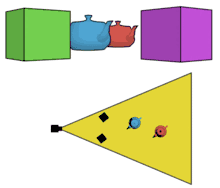Dolly zoom
A dolly zoom is an in-camera effect that appears to undermine normal visual perception.

The effect is achieved by zooming a zoom lens to adjust the angle of view (often referred to as field of view, or FOV) while the camera dollies (moves) toward or away from the subject in such a way as to keep the subject the same size in the frame throughout. In its classic form, the camera angle is pulled away from a subject while the lens zooms in, or vice versa. Thus, during the zoom, there is a continuous perspective distortion, the most directly noticeable feature being that the background appears to change size relative to the subject.
The visual appearance for the viewer is that either the background suddenly grows in size and detail and overwhelms the foreground, or the foreground becomes immense and dominates its previous setting, depending on which way the dolly zoom is executed. As the human visual system uses both size and perspective cues to judge the relative sizes of objects, seeing a perspective change without a size change is a highly unsettling effect, often with strong emotional impact.
The effect was first conceived by Irmin Roberts, a Paramount second-unit cameraman, in Alfred Hitchcock's film Vertigo.[1] The shot has since been used in many other films, including Goodfellas,[2] Jaws,[3] and the Lord of the Rings films.
Alternative names
A dolly zoom is also known as:
Purpose
The dolly zoom is commonly used by filmmakers to represent the sensation of vertigo, a "falling-away-from-oneself feeling" or a feeling of unreality, or to suggest that a character is undergoing a realization that causes them to reassess everything they had previously believed. Alfred Hitchcock popularized the effect, and he used it for a climactic revelation in Vertigo.
Optics
For most purposes, it can be assumed that the image space and the object space are in the same medium. Thus, for an object in focus, the distance between the lens and image plane , the distance between lens and the object , and the focal length are related by
Then the transverse magnification is
The axial magnification of an object at is the rate of change of the lens–image distance as the lens–object distance changes. For an object of finite depth, one can conceive of the average axial magnification as the ratio of the depth of the image and the depth of the object:
One can see that if magnification remains constant, a longer focal length results in a smaller axial magnification, and a smaller focal length in a larger axial magnification. That is, when using a longer focal length while moving the camera/lens away from the object to maintain the same magnification M, objects seem shallower, and the axial distances between objects seem shorter. The opposite—increased axial magnification—happens with shorter focal lengths while moving the camera/lens towards the object.
Calculating distances
To achieve the effect, the camera needs to be positioned at a certain distance from the object that is supposed to remain still during the dolly zoom. The distance depends on how wide the scene is to be filmed and on the field of view (FOV) of the camera lens. Before calculating the distances needed at the different fields of view, the constant width of the scene has to be calculated:
For example, a FOV of 90° and a distance of 2 meters yield a constant width of 4 meters, allowing a 4-meter-wide object to remain still inside the frame during the effect.
References
- Lyttelton, Oliver; Lyttelton, Oliver (2012-05-09). "5 Things You Might Not Know About Alfred Hitchcock's Masterpiece 'Vertigo'". IndieWire. Retrieved 2017-02-01.
- This Is How A Dolly Zoom Works-Fandor on YouTube
- Wickman, Forrest (January 21, 2014). ""The Evolution of the Dolly Zoom," in One Supercut". Slate.
- Norman Holland. "Hitchcock's Vertigo: One Viewer's Viewing".
- "The "Vertigo shot" and the oneiric frame". Archived from the original on 2007-09-15.
- Hardy, Rob (January 21, 2014). "Everything You Need to Know About the Dolly Zoom". nofilmschool.com. No Film School. Retrieved June 17, 2020.
External links
- Vertigo Effect article on TV Tropes